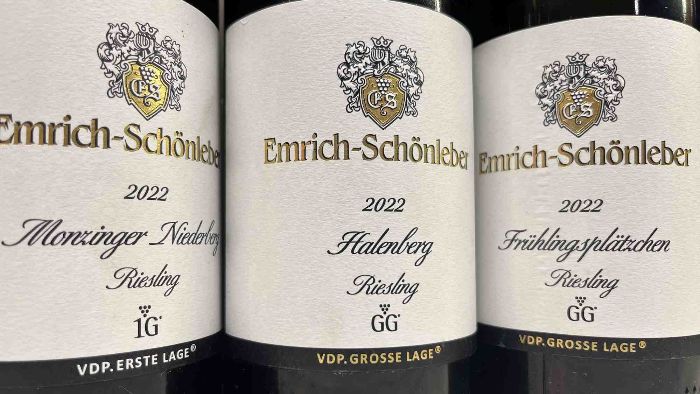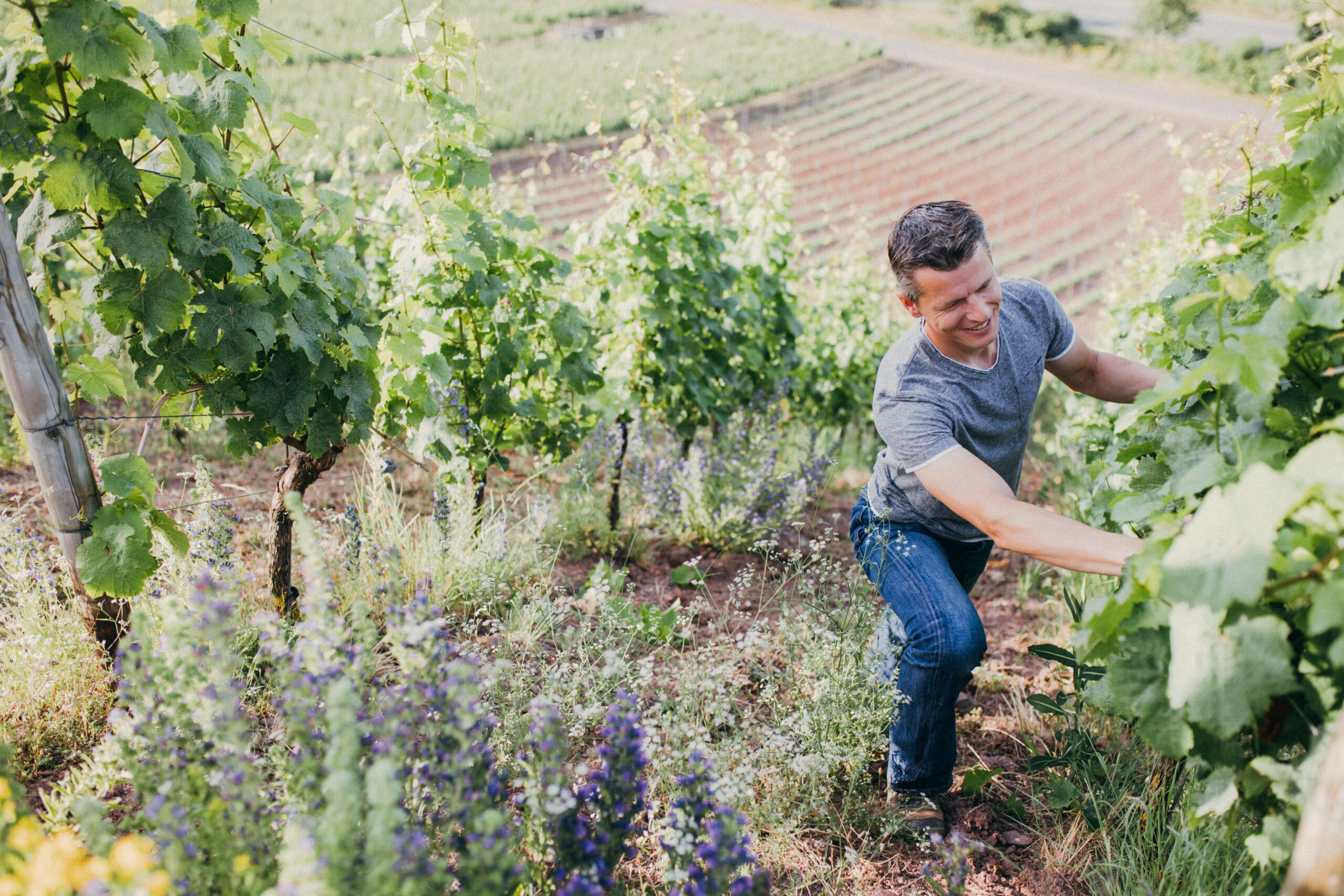Emrich-Schönleber’s premier cru and grand cru dry Rieslings – the Niederberg 1G, Frühlingsplätzchen GG, and Halenberg GG – have just arrived.
These wines represent, without question, the highest echelon of German dry Riesling. They are also the deals of the contemporary GG landscape. The only peers of Schönleber – Keller and Schäfer-Fröhlich – are either unobtainable, or 25-100%+ more expensive, or both and more.
Honestly, I scratch my head about all this sometimes (though also see topic 1, below). I have no doubt the market will figure this out, and of course when it does the wines won’t be available and, verily, everyone will have to have them.
But in the interim these are wines, these are deals, that one should not take for granted. For this brief moment, the wines are available. Enjoy this golden moment.
Yes, this is your cue to order. All pricing and some tasting notes below.
In 2022 these are shockingly nimble wines, damn near Kabinett trocken-like in their delicacy and intensity. If you know me, you know that this is a wild compliment; this is the genius of 2022. These wines are lightness incarnate, they represent a nod to the great trockens of the late 1990s and early 2000s.
Yes, “classic” is now an unquestionable compliment, a badge of honor for wines that remain modest in size, if not in depth. This is the joy of 2022.
With that as an introduction that I think covers the major points, I’d like continue with something of a freeform, absurdist stream-of-consciousness email stumbling and whirling through a number of thoughts about Emrich-Schönleber, the place and status of the GG, why 2022 represents a very special (historic?) vintage for these wines, as well as some absurdist ideas about how to think of dry Rieslings as we become more accustomed to this world.

topic 1: Emrich-Schönleber makes the most difficult wines to read young
To begin, part of the market complexity regarding the wines of Schönleber seem to me due to the fact that these wines are tough to read in youth.
There is just something about the upper Nahe, about Schönleber’s village of Monzingen, that shapes wines of a very specific inward-looking form. In youth, the wines are nearly inscrutable. They can be austere, steely, dense to a point of being chewy. Numerous tasters (spanning a period of nearly a century) have commented that the Nahe can shape wines that resemble the Saar in certain ways. To my palate, there is no estate this is more true of than Emrich-Schönleber.
These wines simply require time and here lies the magic: Without question, some of the greatest aged GGs I’ve ever had have come from Schönleber. There are few estates that have the track record of GGs that Schönleber does. If you can find the GGs of 2004, 2005, 2008, they stand up (and surpass) most of the GGs of this era.
Emrich-Schönleber was rigorous before rigorous was fashionable.
topic 2: Mosel GGs are Chablis; Rheinhessen/Pfalz GGs are Côte d’Or?
I said we’d be a bit absurdist? But the truth is I’ve had to try and make sense of my own two perhaps contradicting beliefs.
My first belief: There is a trilogy of the top producers who have for the last 20 or so years made the most stately and grandiose dry Rieslings in Germany: namely, Emrich-Schönleber, Keller and Schäfer-Fröhlich. These wines (and the other top GGs of the Rheingau, Rheinhessen and Pfalz) simply have a grandiosity about them that Mosel dry wines do not have.
My second belief: Mosel, Saar and Ruwer dry Rieslings are among the most thrilling, agile and razor-sharp dry Rieslings I can think of. They have a completely different architecture: more attenuated, lighter. The diminutive Kabinett Trocken of the Mosel is, for me, perhaps a sort of irreproducible totem – something godly to marvel.
In other words, I love both styles, but there are significant differences. Is the Mosel more Chablis and the other regions more Côte d’Or?
The analogy does not work exactly, but it’s provocative and appropriate enough to, I hope, help people make sense of these different appellations. This analogy also, perhaps, suggests some of the complexity not only of the Nahe, but of the upper Nahe (where Schönleber is) specifically. These wines are literally in the middle, between the regions of the Rheingau, Rheinhessen and Pfalz to the east, and to the Mosel, Saar, and Ruwer to the west.
To me, the wines of the Nahe, and of Emrich-Schönleber specifically, have a unique signature. They have more push, more meat than the Mosel, Saar and Ruwer. Yet they can also be finer, a touch more delicate than most wines from the Rheingau, Rheinhessen and Pfalz.
In short: The Nahe, and again the upper Nahe specifically, is a very special place.
topic 3: the GG has changed everything
I’m not sure we understand how important this category has been; how it has improved the category of German wine… and what it may destroy.
For me, the GG has been the single-most important movement within German wine in the last 20 years. It has changed the landscape completely, opening the world of dry German Riesling to people who were either confused, annoyed, or both confused and annoyed, by the dry Prädikat system that was used before 2002 – the “Kabinett Trocken,” “Spätlese Trocken” and “Auslese Trocken.” The GG, in my opinion, rightly turned the focus away from “ripeness” and moved it toward the land, the vineyard. I don’t think many people can argue this was a bad thing.
The GG has brought thousands, if not millions of people, to German wine. This has been a game changer.
Yet, the drive toward simplicity, toward a system more internationally recognized and accepted, will also wash away some of the cultural quirkiness, the peculiarities and charm of the German Prädikat system. While I can see how it’s pointless to differentiate a dry Kabinett from a dry Spätlese from a dry Auslese, I also think this tradition is crazy and beautiful. To me, it will be sad when all the rough edges of unique cultures are polished away in the name of efficiency and market share.
Why can’t we have GGs and Kabinett Trockens? I want it all.
topic 4: 2002-2022
The 2022 GGs mark the 20th anniversary of the category. So get out there and discuss the GG, buy the GG, drink the GG… maybe raise a glass to the Kabinett Trocken and dream of a more perfekt, more compassionate and understanding world?
To order, email us at orders@vomboden.com and we will connect you with a local retailer in your area.
2022 Riesling Niederberg 1G Premier Cru Dry ~$60
This is one of my favorite wines in the lineup – dense with green citrus, green herbs and minerals. It is more coating and expansive, broader and fierce. It undeniably speaks of a cool place, even though there is a certain generosity, a mouth-watering quality to the stone and citrus fruit that gives it so much energy; that makes it such a joy to drink. To me, this is the perfect expression of the premier cru or 1G level – a bit more rustic than the grandiose GGs but very serious and thrilling.
2022 Riesling Frühlingsplätzchen GG Grand Cru Dry ~$85
This has the coolest name of any vineyard in Germany. It translates, roughly, to “little place of spring.” While the Halenberg is the denser, more monumental wine, with likely more stuffing and structure to age longer, I’ll admit the Frühlingsplätzchen is my favorite. There, I said it. I just love the soaring aromatics, the sharpness of the wine, the linear lightness and delicacy, on special show with the vintage 2022. Many have noted how accessible, how open and giving the 2022 GGs are and this holds true for Schönleber, though they are rarely about fruit as much as they are about a saline quality, mineral and flower. This is a superb, superb GG that dances on the palate like a good old Spätlese Trocken… even Kabinett Trocken? : )
2022 Riesling Halenberg GG Grand Cru Dry ~$95
The Halenberg is the densest and most monumental of the Schönleber GGs. In youth there is both more fruit and more mineral, compared to Frühlingsplätzchen. This is one of the most statuesque and substantial GGs out there, perhaps akin to Keller’s Morstein in density and structure. The energy and openness of 2022 is just thrilling here.
